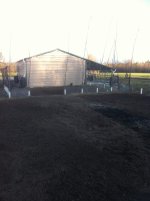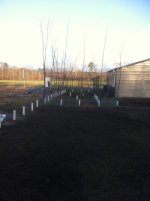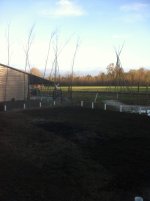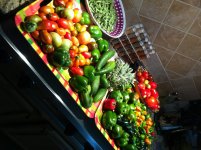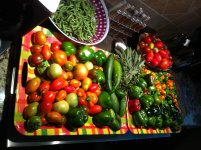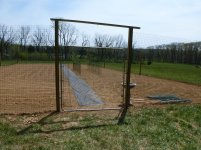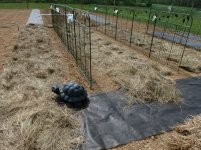I found this article really helpful and while I've been trying to avoid animal waste products, there seems to be other alternatives.
We can get mushroom soil locally, and my brother in law just volunteered to get a large dump truck load for me (he's an excavator with equip) and he doesn't mind taking his own truck "offroad", which I don't blame the commercial guys from shying away from.'
if this doesn't format right, here's the link:
Sources of Nitrogen for Organic Farms
SOURCES OF NITROGEN FOR ORGANIC FARMS
Vern Grubinger
Vegetable and Berry Specialist
University of Vermont Extension
Organic farmers, like any others, need to provide enough nitrogen (N) for crops to maintain good yields, product quality and profitability. But unlike conventional farmers, organic farmers rarely rely primarily on bagged N fertilizers. That would be costly and inconsistent with the organic approach to soil fertility, which emphasizes rotation with leguminous cover crops and application of compost or manure. However, many organic farmers do need to supplement these sources with N fertilizer, and there are many different sources to choose from. Determining which organic fertilizer material to use, how much to apply and when to apply it is just as important organically as it is conventionally, although itç—´ a bit more challenging.
First, you need to know how much available N is recommended for the crop. The New England Vegetable Management Guide and Knottç—´ Handbook for Vegetable Growers provide these numbers for specific crops. A reasonable average for mixed vegetables in the northeast is 125 pounds per acre. Small, short season crops like lettuce obviously require less; high-yield long season crops like potatoes may require more. Next, subtract how much N will be released from your soilç—´ organic matter (OM) over the season. A conservative estimate is 10 pounds for each percent of soil OM, up to 4 percent. Finally, calculate how much N will be provided by cover crops, compost and manure, and subtract that. Whatç—´ left is the fertilizer N requirement.
Legume cover crops, or green manures, can be an excellent source of N when grown in a crop rotation system that includes them on enough land and allows adequate time to produce sufficient biomass. Incorporating a vigorous stand of alfalfa, red clover or hairy vetch early in the season can provide most if not all the N needed by a subsequent vegetable crop. These crops may contain 100-200 lb of N per acre. About half the N in a green manure will be released during decomposition following incorporation. The Northeast Cover Crop Handbook explains how to estimate the N content of various cover crops by multiplying percent dry matter by N content.
Manures and composts contain and release N in varying amounts. Fresh dairy manure promptly incorporated should provide at least 5 pounds of available N per ton. Fresh poultry manure provides about 3 times that amount. Mature compost generally contains about 1% total N, but that varies depending on how itç—´ made. As compost ages, the availability of the N it contains tends to decrease. In most cases only about 10% of the total N in compost will be available to a crop in the year of application. Thatç—´ about 2 lb per ton, or 3/4 lb per cubic yard. Laboratory testing helps determine the nutrient content and availability of manure or compost.
Organic fertilizers include animal by-products, plant-derived materials and mined minerals. These can be purchased individually or as fertilizer blends. Many of these materials also contain other nutrients, and some contain carbon, which will help maintain soil OM and soil structure. As with conventional fertilizers, cost is lowest when purchasing in bulk.
ORGANIC % N C/N LB N/TON EXAMPLE $/LB N RELEASE COMMENTS
SOURCE OF N FOB COST/TON RATE
fresh dairy manure 0.5 18 11 $ 8 $0.72 medium 0.5-0.1-0.5, has weed seeds, consistency varies
fresh cage layer manure 1.5 7 30 $15 $0.50 rapid 1.5-1-0.5, may be hard to handle, can burn
poultry manure compost 4 15 80 $251 $3.13 slow 3-4-3 analysis varies, may be pelletized
finished ç´*ield compost 1.2 17 24 $25 $1.04 slow 1-1-1 analysis varies, aids soil 蘇ealth
legume hay 2.5 16 50 you grow you grow medium strong stand with tops provides most N
grass hay 1.2 32 25 you grow you grow medium releases N when young; old growth ties N up
alfalfa meal 2.7 15 54 $348 $6.44 medium 3-0.5-3, feed grade by the ton
soybean meal 6 7 120 $314 $2.62 medium 6-1-2, feed grade by the ton
blood meal 12 3 260 $1,146 $4.41 rapid 13-2-0, mad cow risk similair to eating meat
cottonseed meal 6 7 120 $ 736 $6.13 slow 6-2-2 analysis, 85% water insoluble N
crab meal 5 4 100 $ 628 $6.28 medium 5-2-0.5 analysis, 15% Ca
fish meal 9 4 180 $1,157 $6.42 rapid 9-3-0, smelly, dusty, may contain high salts
feather meal 10 4 200 $ 968 $4.84 vy. slow contains protein slow to break down
Chilean nitrate 16 no C 320 $ 500 $1.56 rapid organic standards limit usage
å–„ro-Gro?-3-4 5 3 100 $ 340 $3.40 medium balanced organic fertilizer blend
å–„ro-Booster?0-0-0 10 2 200 $ 375 $1.87 medium vegetable and plant meals plus 1/3 Chilean
